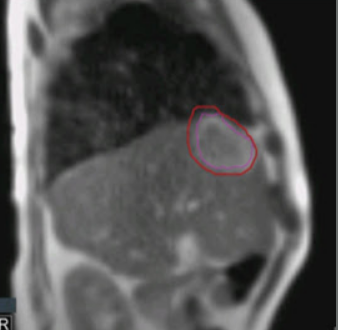WEBINAR: Treating Tumors that Move: The Promise and Practice of Real-time MR Image Guidance During Radiation Beam Delivery
Webinar is sponsored by ViewRay

Respiratory tumor motion often complicates the delivery of precision radiation treatment. Over the past two decades, radiotherapy researchers and clinicians have pursued several approaches to motion management. However, the approaches lacked continuous, high-quality soft tissue visualization linked to an automated beam-gating technology that would see when a tumor moved out of margin range and halt the delivery of radiation until it returned to a prescribed area (PTV).
With the introduction of magnetic resonance image (MRI) guidance and real-time image guidance during beam delivery, the ability to lessen or eliminate radiation dose to surrounding tissues and organs is achievable. Several studies have demonstrated: (1) the ability to reduce to a minimum the margin expansion necessary to account for motion error while reducing doses to nearby organs at risk, and (2) the ability to obtain duty cycles equal to or greater than those common to conventional gating.
In this webinar, two speakers will share their clinical experience with this MRI-Guided RT technology.
This webinar took place Sept. 20, 2018 — Register to view the archive version the webinar
Presenters:
 John Ng, M.D.
John Ng, M.D.
Assistant Professor and Director of Medical Student Education in Radiation Oncology at Weill Cornell Medicine
[email protected]
John Ng is a Board Certified Radiation Oncologist and Assistant Professor of Radiation Oncology at Weill Cornell Medical College/New York Presbyterian Hospital. Dr. Ng attended Columbia University and then received an M.S. degree in Biophysics from Harvard University. He obtained his M.D. degree from Harvard Medical School, jointly with the Massachusetts Institute of Technology, as part of the Health Sciences and Technology (HST) program. Joining Weill Cornell Medical Center, he serves as attending physician for Breast Oncology and for Gastrointestinal Oncology. His current focus is on exploring emerging radiation technologies such as magnetic resonance imaging (MRI) guided radiation as a way of amplifying the host immune response to cancer cells.
 Kathryn Mittauer, Ph.D., DABR
Kathryn Mittauer, Ph.D., DABR
Staff Medical Physicist at University of Wisconsin-Madison
[email protected]
Mittauer is a staff medical physicist and researcher at the University of Wisconsin-Madison. She has specialized in clinical implementation and coverage of MR-guided radiotherapy with the ViewRay MRIdian system since 2015. She has a master’s degree in medical physics from the University of Kentucky and a doctorate in medical physics from the University of Florida. She completed her residency in medical physics at the University of Wisconsin-Madison. Her research efforts include using online adaptive MR-guided radiotherapy to assess normal tissue toxicities and dose escalation strategies.
About ViewRay
ViewRay Inc. (Nasdaq: VRAY), designs, manufactures and markets the MRIdian radiation therapy system. MRIdian is built upon a proprietary high-definition MR imaging system designed from the ground up to address the unique challenges and clinical workflow for advanced radiation oncology. Unlike MR systems used in diagnostic radiology, MRIdian’s high-definition MR was purposely built to address specific challenges, including beam distortion, skin toxicity and other concerns that may potentially arise when high magnetic fields interact with radiation beams. ViewRay and MRIdian are registered trademarks of ViewRay Inc.


 August 09, 2024
August 09, 2024 








